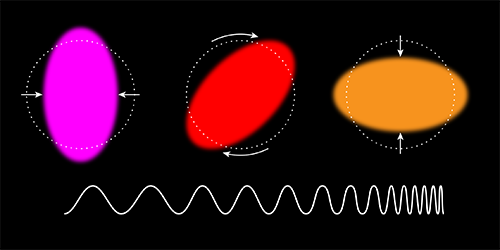Feeling the Squeeze at All Frequencies
Gravitational-wave observatories have recently begun “squeezing” the light in their detectors, which reduces noise and improves sensitivity but only in a limited frequency range. Now two groups have demonstrated a method that reduces noise over a wide range of gravitational-wave frequencies. This quantum squeezing technique, when deployed with other planned upgrades, should double the sensitivity of gravitational-wave observatories.
Detecting gravitational waves involves beaming lasers back and forth in long-armed interferometers and looking for changes in the interference. The signal is affected by quantum noise in the light, which has amplitude and phase components. Amplitude noise dominates at low gravitational-wave frequencies, while phase noise is more of a problem at high frequencies.
Current squeezing devices—deployed on the LIGO and Virgo detectors—reduce phase noise and improve sensitivity at high frequencies, above 50 Hz (see Focus: Squeezing More from Gravitational-Wave Detectors). However, the two noise components are coupled such that this phase squeezing causes an increase in amplitude noise and a subsequent drop in sensitivity at low frequencies. Researchers represent this tradeoff with a “squeeze ellipse” that is like a balloon being squished in one direction and expanding in another.
The way to avoid this compromise is with frequency-dependent squeezing, as demonstrated by a group from the LIGO Collaboration and another group comprising researchers from the KAGRA, Virgo, and GEO experiments. Both teams have built filter cavities that take in phase-squeezed light and “rotate” the ellipse, so it becomes amplitude-squeezed for measuring low-frequency gravitational waves.
The plan is to have filter cavities like these installed for the next round of observing that should start in 2022. Eventually, this and other improvements are expected to give an eightfold increase in detection rate, for both black hole and neutron star mergers, which are observable, respectively, at low and high frequencies.
This research is published in Physical Review Letters.
–Michael Schirber
Michael Schirber is a Corresponding Editor for Physics based in Lyon, France.




